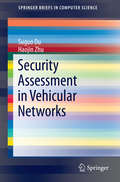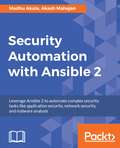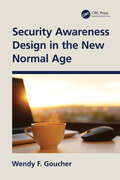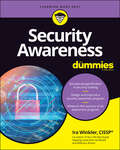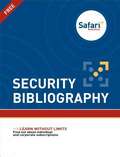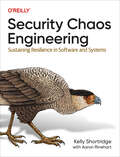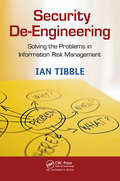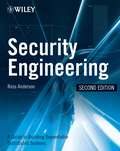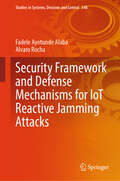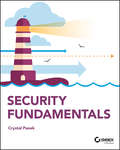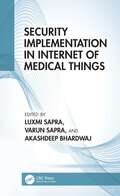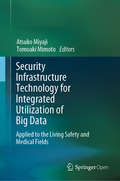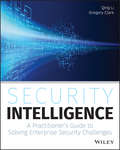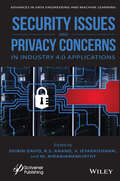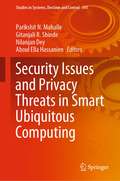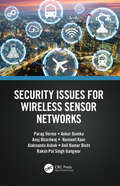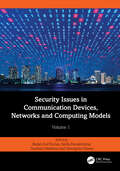- Table View
- List View
Security Assessment in Vehicular Networks
by Suguo Du Haojin ZhuThis book presents several novel approaches to model the interaction between the attacker and the defender and assess the security of Vehicular Ad Hoc Networks (VANETs). The first security assessment approach is based on the attack tree security assessment model, which leverages tree based methods to analyze the risk of the system and identify the possible attacking strategies the adversaries may launch. To further capture the interaction between the attacker and the defender, the authors propose to utilize the attack-defense tree model to express the potential countermeasures which could mitigate the system. By considering rational participants that aim to maximize their payoff function, the brief describes a game-theoretic analysis approach to investigate the possible strategies that the security administrator and the attacker could adopt. A phased attack-defense game allows the reader to model the interactions between the attacker and defender for VANET security assessment. The brief offers a variety of methods for assessing the security of wireless networks. Professionals and researchers working on the defense of VANETs will find this material valuable.
Security Automation with Ansible 2: Leverage Ansible 2 to automate complex security tasks like application security, network security, and malware analysis
by Akash Mahajan Madhu AkulaAutomate security-related tasks in a structured, modular fashion using the best open source automation tool available About This Book • Leverage the agentless, push-based power of Ansible 2 to automate security tasks • Learn to write playbooks that apply security to any part of your system • This recipe-based guide will teach you to use Ansible 2 for various use cases such as fraud detection, network security, governance, and more Who This Book Is For If you are a system administrator or a DevOps engineer with responsibility for finding loop holes in your system or application, then this book is for you. It's also useful for security consultants looking to automate their infrastructure's security model. What You Will Learn • Use Ansible playbooks, roles, modules, and templating to build generic, testable playbooks • Manage Linux and Windows hosts remotely in a repeatable and predictable manner • See how to perform security patch management, and security hardening with scheduling and automation • Set up AWS Lambda for a serverless automated defense • Run continuous security scans against your hosts and automatically fix and harden the gaps • Extend Ansible to write your custom modules and use them as part of your already existing security automation programs • Perform automation security audit checks for applications using Ansible • Manage secrets in Ansible using Ansible Vault In Detail Security automation is one of the most interesting skills to have nowadays. Ansible allows you to write automation procedures once and use them across your entire infrastructure. This book will teach you the best way to use Ansible for seemingly complex tasks by using the various building blocks available and creating solutions that are easy to teach others, store for later, perform version control on, and repeat. We'll start by covering various popular modules and writing simple playbooks to showcase those modules. You'll see how this can be applied over a variety of platforms and operating systems, whether they are Windows/Linux bare metal servers or containers on a cloud platform. Once the bare bones automation is in place, you'll learn how to leverage tools such as Ansible Tower or even Jenkins to create scheduled repeatable processes around security patching, security hardening, compliance reports, monitoring of systems, and so on. Moving on, you'll delve into useful security automation techniques and approaches, and learn how to extend Ansible for enhanced security. While on the way, we will tackle topics like how to manage secrets, how to manage all the playbooks that we will create and how to enable collaboration using Ansible Galaxy. In the final stretch, we'll tackle how to extend the modules of Ansible for our use, and do all the previous tasks in a programmatic manner to get even more powerful automation frameworks and rigs. Style and approach This comprehensive guide will teach you to manage Linux and Windows hosts remotely in a repeatable and predictable manner. The book takes an in-depth approach and helps you understand how to set up complicated stacks of software with codified and easy-to-share best practices.
Security Awareness Design in the New Normal Age
by Wendy F. GoucherPeople working in our cyber world have access to a wide range of information including sensitive personal or corporate information which increases the risk to it. One of the aspects of the protection of this data is to train the user to behave more securely. This means that every person who handles sensitive information, their own or that of other people, be aware of the risks that their use can pose as well as how to do their job in such a way as to reduce that risk. The approach we use for that is called ‘Security awareness’ but would be more accurately described as security ‘un-awareness’ because most of the problems come where the user doesn’t know about a risk from their behaviour, or its potential impact. In these post COVID days of ‘New Normal’ working, in which staff spend more of their time working at home, organisations are still responsible for the protection of sensitive personal and corporate data. This means that it is more important than ever to create an effective security awareness communication process. This book will primarily consider the problem of hitting that ‘Sweet Spot’ in the age of ‘New Normal' working, which means that the knowledge about secure practice is not only understood and remembered, but also reliably put into practice – even when a person is working alone. This will be informed by academic research as well as experience, both my own and learnt from my fellow professionals, and then will be used to demonstrate how ‘New Normal’ working can improve security awareness as well as challenge it.
Security Awareness For Dummies
by Ira WinklerMake security a priority on your team Every organization needs a strong security program. One recent study estimated that a hacker attack occurs somewhere every 37 seconds. Since security programs are only as effective as a team’s willingness to follow their rules and protocols, it’s increasingly necessary to have not just a widely accessible gold standard of security, but also a practical plan for rolling it out and getting others on board with following it. Security Awareness For Dummies gives you the blueprint for implementing this sort of holistic and hyper-secure program in your organization. Written by one of the world’s most influential security professionals—and an Information Systems Security Association Hall of Famer—this pragmatic and easy-to-follow book provides a framework for creating new and highly effective awareness programs from scratch, as well as steps to take to improve on existing ones. It also covers how to measure and evaluate the success of your program and highlight its value to management. Customize and create your own program Make employees aware of the importance of security Develop metrics for success Follow industry-specific sample programs Cyberattacks aren’t going away anytime soon: get this smart, friendly guide on how to get a workgroup on board with their role in security and save your organization big money in the long run.
Security Bibliography
by Safari Content TeamPeople are increasingly concerned by the security of the information they put online and worry about their privacy and their online profile. With new attacks, information leaks, vulnerabilities and exploits published every week, information security is a constant learning process. To be effective and stay up to date, you need the right resources to make sure you can quickly access any needed information. Obtaining the details you need is like trying to find a needle in a haystack. From general IT security knowledge and certifications to specialized content such as exploit writing, this bibliography brings together the right resources to help you get the information you need to solve any problem in IT security. We cover mobile and network security, cyber warfare and cyber crime and how to confront malware, including detection, development and forensics. And with more and more code written every day, secure coding is crucial, and we cover books on secure development, cryptography development, guidelines and best practices.
Security Breach Files Updated Edition: An AFK Book (Five Nights At Freddy's)
by Scott CawthonCrack open this updated edition of the Security Breach Files for a deep dive into the terrifying game!All that you want to know about the first free-roam Five Nights at Freddy's game is presented here in vivid detail, with thirty-two new pages taking you through the free story "Ruin".This comprehensive breakdown covering gameplay, secrets, Easter eggs, and alternate endings for both the main game and DLC will deepen the knowledge of even the most enthusiastic player. All the evidence, along with every detail of the newest entry into the world of Five Nights at Freddy's is laid out for fans to explore in this one-of-a-kind guide.
Security Challenges and Approaches in Internet of Things
by Muthucumaru Maheswaran Sridipta Misra Salman HashmiThis book provides a comprehensive survey of the security and privacy research advancements in Internet of Things (IoT). The book lays the context for the discussion by introducing a system model for IoT. Since IoT is very varied and has been introduced in many different contexts, the system model introduced plays a crucial role in integrating the concepts into a coherent framework. After the system model, the book introduces the vulnerable features of the IoT. By providing a comprehensive discussion of the vulnerable features, the book highlights the problem areas of IoT that should be studied concerning security and privacy. Using the vulnerable features as a motivation, the book presents a vast survey of existing security and privacy approaches for IoT. The survey is a good way for the reader to pick up interesting directions of research that have already been explored and also hints at directions that could take additional investigation. Finally, the book presents four case studies that provide a detailed view of how some of the security and privacy concerns are addressed in specific problem areas.
Security Chaos Engineering: Sustaining Resilience in Software and Systems
by Kelly ShortridgeCybersecurity is broken. Year after year, attackers remain unchallenged and undeterred, while engineering teams feel pressure to design, build, and operate "secure" systems. Failure can't be prevented, mental models of systems are incomplete, and our digital world constantly evolves. How can we verify that our systems behave the way we expect? What can we do to improve our systems' resilience? In this comprehensive guide, authors Kelly Shortridge and Aaron Rinehart help you navigate the challenges of sustaining resilience in complex software systems by using the principles and practices of security chaos engineering. By preparing for adverse events, you can ensure they don't disrupt your ability to innovate, move quickly, and achieve your engineering and business goals. Learn how to design a modern security programMake informed decisions at each phase of software delivery to nurture resilience and adaptive capacityUnderstand the complex systems dynamics upon which resilience outcomes dependNavigate technical and organizational trade-offsthat distort decision making in systemsExplore chaos experimentation to verify critical assumptions about software quality and securityLearn how major enterprises leverage security chaos engineering
Security Compliance in Model-driven Development of Software Systems in Presence of Long-Term Evolution and Variants
by Sven Matthias PeldszusFor ensuring a software system's security, it is vital to keep up with changing security precautions, attacks, and mitigations. Although model-based development enables addressing security already at design-time, design models are often inconsistent with the implementation or among themselves. An additional burden are variants of software systems. To ensure security in this context, we present an approach based on continuous automated change propagation, allowing security experts to specify security requirements on the most suitable system representation. We automatically check all system representations against these requirements and provide security-preserving refactorings for preserving security compliance. For both, we show the application to variant-rich software systems. To support legacy systems, we allow to reverse-engineer variability-aware UML models and semi-automatically map existing design models to the implementation. Besides evaluations of the individual contributions, we demonstrate the approach in two open-source case studies, the iTrust electronics health records system and the Eclipse Secure Storage.
Security De-Engineering: Solving the Problems in Information Risk Management
by Ian TibbleAs hacker organizations surpass drug cartels in terms of revenue generation, it is clear that the good guys are doing something wrong in information security. Providing a simple foundational remedy for our security ills, Security De-Engineering: Solving the Problems in Information Risk Management is a definitive guide to the current problems i
Security Designs for the Cloud, IoT, and Social Networking
by Chintan Bhatt Dac-Nhuong Le Mani MadhukarSecurity concerns around the rapid growth and variety of devices that are controlled and managed over the Internet is an immediate potential threat to all who own or use them. This book examines the issues surrounding these problems, vulnerabilities, what can be done to solve the problems, investigating the roots of the problems and how programming and attention to good security practice can combat the threats today that are a result of lax security processes on the Internet of Things, cloud computing and social media.
Security Engineering
by Ross J. AndersonThe world has changed radically since the first edition of this book was published in 2001. Spammers, virus writers, phishermen, money launderers, and spies now trade busily with each other in a lively online criminal economy and as they specialize, they get better. In this indispensable, fully updated guide, Ross Anderson reveals how to build systems that stay dependable whether faced with error or malice. Here?s straight talk on critical topics such as technical engineering basics, types of attack, specialized protection mechanisms, security psychology, policy, and more.
Security Engineering for Embedded and Cyber-Physical Systems (Advances In Cybersecurity Management Ser.)
by Yassine Maleh Saad MotahhirDigital transformation, also known as Industry 4.0, Smart Industry, and Smart Manufacturing, is at the top of leaders’ agendas. Such a transformation stimulates innovation in new products and services, the digital transformation of processes, and the creation of new business models and ecosystems. In the world of manufacturing, Industry 4.0 is based on various technological advances, among which we can mainly cite CPS (cyber-physical systems), IoT (Internet of Things), and IoS (internet of services). While engaging, this fourth wave also brings significant challenges for manufacturers. Business operations and the supply chain are becoming more vulnerable to cyber threats. Security Engineering for Embedded and Cyber-Physical Systems is an invaluable resource to discover cybersecurity and privacy techniques for embedded and cyber-physical systems. This book presents the latest studies and research results on all aspects of security engineering for embedded and cyber-physical systems. It also provides a premier interdisciplinary reference for researchers, practitioners, and educators to discover the most recent innovations, trends, concerns, and practical challenges encountered and solutions adopted in security engineering for embedded and cyber-physical systems. The book offers comprehensive coverage of the essential topics, including the following: Embedded and cyber-physical systems threats and vulnerabilities Security engineering techniques for embedded and cyber-physical systems Security engineering for embedded and cyber-physical systems and potential future-use cases Artificial intelligence techniques for cybersecurity and privacy Security engineering for Internet of Things Blockchain for cybersecurity in embedded and cyber-physical systems This book comprises a number of state-of-the-art contributions from both scientists and practitioners working in security engineering for embedded and cyber-physical systems. It aspires to provide a relevant reference for students, researchers, engineers, and professionals working in this area or those interested in grasping its diverse facets and exploring the latest advances and future trends related to security engineering for embedded and cyber-physical systems.
Security Engineering: A Guide to Building Dependable Distributed Systems
by Ross AndersonNow that there’s software in everything, how can you make anything secure? Understand how to engineer dependable systems with this newly updated classic In Security Engineering: A Guide to Building Dependable Distributed Systems, Third Edition Cambridge University professor Ross Anderson updates his classic textbook and teaches readers how to design, implement, and test systems to withstand both error and attack. This book became a best-seller in 2001 and helped establish the discipline of security engineering. By the second edition in 2008, underground dark markets had let the bad guys specialize and scale up; attacks were increasingly on users rather than on technology. The book repeated its success by showing how security engineers can focus on usability. Now the third edition brings it up to date for 2020. As people now go online from phones more than laptops, most servers are in the cloud, online advertising drives the Internet and social networks have taken over much human interaction, many patterns of crime and abuse are the same, but the methods have evolved. Ross Anderson explores what security engineering means in 2020, including: How the basic elements of cryptography, protocols, and access control translate to the new world of phones, cloud services, social media and the Internet of Things Who the attackers are – from nation states and business competitors through criminal gangs to stalkers and playground bullies What they do – from phishing and carding through SIM swapping and software exploits to DDoS and fake news Security psychology, from privacy through ease-of-use to deception The economics of security and dependability – why companies build vulnerable systems and governments look the other way How dozens of industries went online – well or badly <l
Security Framework and Defense Mechanisms for IoT Reactive Jamming Attacks (Studies in Systems, Decision and Control #548)
by Alvaro Rocha Fadele Ayotunde AlabaThis book digs into the important confluence of cybersecurity and big data, providing insights into the ever-changing environment of cyber threats and solutions to protect these enormous databases. In the modern digital era, large amounts of data have evolved into the vital organs of businesses, providing the impetus for decision-making, creativity, and a competitive edge. Cyberattacks pose a persistent danger to this important resource since they can result in data breaches, financial losses, and harm to an organization's brand. Features of particular interest include: a. Understanding the Threat Landscape: The book gives a complete review of the many different types of cyber threats that target big data, including data breaches, ransomware attacks, and insider threats. b. Analysing Real-World Case Studies: The purpose of this section is to provide the reader with useful insights into the strategies, methods, and processes that cyber adversaries use via the in-depth examination of real-world assaults on big data. c. Strategies for Risk Mitigation: This book provides a comprehensive and actionable approach to reducing the dangers of cyberattacks on large amounts of data. It encompasses a broad variety of tactics, including network protection, encoding, and access restrictions d. Emerging Technologies: This section introduces readers to cutting-edge technologies and best practices for securing large data. e. Compliance with Regulations: The book examines the regulatory environment that governs data protection and privacy, including the General Data Protection Regulation (GDPR), the California Consumer Privacy Act (CCPA), and industry-specific requirements. f. Trends of the Future: This book covers current trends and issues in cybersecurity and gives forward-looking views into the future of big data security. This is done in recognition that the cybersecurity environment is always shifting and developing. g. Contributors of Expertise: The book includes contributions from industry practitioners, data scientists, and cybersecurity specialists who have hands-on experience defending large data settings.
Security Framework for The Internet of Things Applications (Computational Methods for Industrial Applications)
by Quan Z. Sheng Wei Emma Zhang Salma Abdalla HamadThe text highlights a comprehensive survey that focuses on all security aspects and challenges facing the Internet of Things systems, including outsourcing techniques for partial computations on edge or cloud while presenting case studies to map security challenges. It further covers three security aspects including Internet of Things device identification and authentication, network traffic intrusion detection, and executable malware files detection.This book: Presents a security framework model design named Behavioral Network Traffic Identification and Novelty Anomaly Detection for the IoT Infrastructures Highlights recent advancements in machine learning, deep learning, and networking standards to boost Internet of Things security Builds a near real-time solution for identifying Internet of Things devices connecting to a network using their network traffic traces and providing them with sufficient access privileges Develops a robust framework for detecting IoT anomalous network traffic Covers an anti-malware solution for detecting malware targeting embedded devices It will serve as an ideal text for senior undergraduate and graduate students, and professionals in the fields of electrical engineering, electronics and communication engineering, computer engineering, and information technology.
Security Fundamentals
by Crystal PanekA Sybex guide to Windows Security concepts, perfect for IT beginners Security is one of the most important components to every company’s computer network. That’s why the Security Fundamentals MTA Certification is so highly sought after. Filling IT positions is a top problem in today’s businesses, so this certification could be your first step toward a stable and lucrative IT career. Security Fundamentals is your guide to developing a strong foundational understanding of Windows security, so you can take your IT career to the next level and feel confident going into the certification exam. Security Fundamentals features approachable discussion of core security concepts and topics, and includes additional learning tutorials and tools. This book covers everything you need to know about security layers, authentication, authorization, security policies, and protecting your server and client. Each chapter closes with a quiz so you can test your knowledge before moving to the next section. Learn everything you need for the Security Fundamentals MTA Certification Understand core security principles, including security layers and network security Learn essential concepts in physical security, internet security, and wireless security Identify the different types of hardware firewalls and their characteristics Test your knowledge and practice for the exam with quiz questions in every chapter IT professionals looking to understand more about networking will gain the knowledge to effectively secure a client and server, and to confidently explain basic security concepts. Thanks to the tools and tips in this Sybex title, you will be able to apply your new IT security skills in real world situations and on exam day.
Security Implementation in Internet of Medical Things
by Akashdeep Bhardwaj Varun Sapra Luxmi SapraSecurity implementation is crucial in the Internet of Medical Things (IoMT) as it ensures the protection of sensitive medical data and prevents unauthorized access to or manipulation of devices and systems. This book covers different aspects of security implementations and challenges in IoMT and aims to bring researchers together to contribute their findings to recommend new methodologies and feasible solutions for implementing security and novel architectures in artificial intelligence, machine learning, and data science in the field of healthcare and IoT. IoMT includes a wide range of connected medical devices and systems, such as wearable devices, medical sensors, and electronic health records, that collect, store, and share sensitive medical information. Without proper security measures, this information could be compromised, leading to serious privacy breaches, financial fraud, and even physical harm to patients.
Security Informatics
by Hsinchun Chen Jau-Hwang Wang Michael Chau Christopher C. YangIntelligence and Security Informatics (ISI) is defined as the study of the development and use of advanced information systems and technologies for national, international, and societal security-related applications. With the rise of global terrorism, the field has been given an increasing amount of attention from academic researchers, law enforcement, intelligent experts, information technology consultants and practitioners. SECURITY INFORMATICS is global in scope and perspective. Leading experts will be invited as contributing authors from the US, UK, Denmark, Israel, Singapore, Hong Kong, Taiwan, Europe, etc. It is the first systematic, archival volume treatment of the field and will cover the very latest advances in ISI research and practice. It is organized in four major subject areas: (1) Information and Systems Security, (2) Information Sharing and Analysis in Security Informatics, (3) Infrastructure Protection and Emergency Responses, and (4) National Security and Terrorism Informatics.
Security Infrastructure Technology for Integrated Utilization of Big Data: Applied to the Living Safety and Medical Fields
by Atsuko Miyaji Tomoaki MimotoThis open access book describes the technologies needed to construct a secure big data infrastructure that connects data owners, analytical institutions, and user institutions in a circle of trust. It begins by discussing the most relevant technical issues involved in creating safe and privacy-preserving big data distribution platforms, and especially focuses on cryptographic primitives and privacy-preserving techniques, which are essential prerequisites. The book also covers elliptic curve cryptosystems, which offer compact public key cryptosystems; and LWE-based cryptosystems, which are a type of post-quantum cryptosystem. Since big data distribution platforms require appropriate data handling, the book also describes a privacy-preserving data integration protocol and privacy-preserving classification protocol for secure computation. Furthermore, it introduces an anonymization technique and privacy risk evaluation technique.This book also describes the latest related findings in both the living safety and medical fields. In the living safety field, to prevent injuries occurring in everyday life, it is necessary to analyze injury data, find problems, and implement suitable measures. But most cases don’t include enough information for injury prevention because the necessary data is spread across multiple organizations, and data integration is difficult from a security standpoint. This book introduces a system for solving this problem by applying a method for integrating distributed data securely and introduces applications concerning childhood injury at home and school injury. In the medical field, privacy protection and patient consent management are crucial for all research. The book describes a medical test bed for the secure collection and analysis of electronic medical records distributed among various medical institutions. The system promotes big-data analysis of medical data with a cloud infrastructure and includes various security measures developed in our project to avoid privacy violations.
Security Intelligence
by Gregory Clark Qing LiSimilar to unraveling a math word problem, Security Intelligence: A Practitioner's Guide to Solving Enterprise Security Challenges guides you through a deciphering process that translates each security goal into a set of security variables, substitutes each variable with a specific security technology domain, formulates the equation that is the deployment strategy, then verifies the solution against the original problem by analyzing security incidents and mining hidden breaches, ultimately refines the security formula iteratively in a perpetual cycle. You will learn about: Secure proxies - the necessary extension of the endpoints Application identification and control - visualize the threats Malnets - where is the source of infection and who are the pathogens Identify the security breach - who was the victim and what was the lure Security in Mobile computing - SNAFU With this book, you will be able to: Identify the relevant solutions to secure the infrastructure Construct policies that provide flexibility to the users so to ensure productivity Deploy effective defenses against the ever evolving web threats Implement solutions that are compliant to relevant rules and regulations Offer insight to developers who are building new security solutions and products
Security Issues and Privacy Concerns in Industry 4.0 Applications
by M. Niranjanamurthy Shibin David R. S. Anand V. JeyakrishnanThe scope of Security Issues, Privacy Concerns in Industry 4.0 Applications is to envision the need for security in Industry 4.0 applications and the research opportunities for the future. This book discusses the security issues in the Industry 4.0 applications for research development. It will also enable the reader to develop solutions for the security threats and attacks that prevail in the industry. The chapters will be framed on par with advancements in the industry in the area of Industry 4.0 with its applications in additive manufacturing, cloud computing, IoT (Internet of Things), and many others. This book helps a researcher and an industrial specialist to reflect on the latest trend and the need for technological change in Industry 4.0. Smart water management using IoT, cloud security issues with network forensics, regional language recognition for industry 4.0, IoT based health care management system, artificial intelligence for fake profile detection, and packet drop detection in agriculture-based IoT are covered in this outstanding new volume. Leading innovations such as smart drone for railway track cleaning, everyday life-supporting blockchain and big data, effective prediction using machine learning, classification of the dog breed based on CNN, load balancing using the SPE approach and cyber culture impact on media consumers are also addressed. Whether a reference for the veteran engineer or an introduction to the technologies covered in the book for the student, this is a must-have for any library.
Security Issues and Privacy Threats in Smart Ubiquitous Computing (Studies in Systems, Decision and Control #341)
by Aboul Ella Hassanien Nilanjan Dey Parikshit N. Mahalle Gitanjali R. ShindeThis book extends the work from introduction of ubiquitous computing, to the Internet of things to security and to privacy aspects of ubiquitous computing. The uniqueness of this book is the combination of important fields like the Internet of things and ubiquitous computing. It assumes that the readers’ goal is to achieve a complete understanding of IoT, smart computing, security issues, challenges and possible solutions. It is not oriented towards any specific use cases and security issues; privacy threats in ubiquitous computing problems are discussed across various domains. This book is motivating to address privacy threats in new inventions for a wide range of stakeholders like layman to educated users, villages to metros and national to global levels. This book contains numerous examples, case studies, technical descriptions, scenarios, procedures, algorithms and protocols. The main endeavour of this book is threat analysis and activity modelling of attacks in order to give an actual view of the ubiquitous computing applications. The unique approach will help readers for a better understanding.
Security Issues for Wireless Sensor Networks
by Ankur Dumka Alaknanda Ashok Parag Verma Anuj Bhardwaj Navneet Kaur Anil Kumar Bisht Raksh Pal GangwarWireless sensor networks (WSNs) have attracted high interest over the last few decades in the wireless and mobile computing research community. Applications of WSNs are numerous and growing, including indoor deployment scenarios in the home and office to outdoor deployment in an adversary’s territory in a tactical background. However, due to their distributed nature and deployment in remote areas, these networks are vulnerable to numerous security threats that can adversely affect their performance. This problem is more critical if the network is deployed for some mission-critical applications, such as in a tactical battlefield. Random failure of nodes is also very likely in real-life deployment scenarios. Due to resource constraints in the sensor nodes, a traditional security mechanism with high overhead of computation and communication is not feasible in WSNs. Design and implementation of secure WSNs is, therefore, a particularly challenging task. This book covers a comprehensive discussion on state-of-the-art security technologies for WSNs. It identifies various possible attacks at different layers of the communication protocol stack in a typical WSN and presents their possible countermeasures. A brief discussion on the future direction of research in WSN security is also included.
Security Issues in Communication Devices, Networks and Computing Models: Volume 1
by Gheorghita Ghinea Budati Anil Kumar Akella Ramakrishna Goutham MakkenaThe importance of addressing security issues in communication devices, networks, and computing models in Industry 5.0 cannot be overstated. Industry 5.0 represents the next phase in the evolution of manufacturing and industrial processes, characterized by increased connectivity, automation, and the integration of smart technologies. Here are several reasons why security is crucial in this context: Industry 5.0 involves the convergence of information technology (IT) and operational technology (OT), making industrial control systems susceptible to cyber threats. A breach in security could compromise critical infrastructure such as power grids, transportation systems, and water treatment plants. Securing computing models and networks is vital for protecting critical infrastructure and ensuring the safety and stability of essential services.Industry 5.0 encourages the use of advanced technologies such as the Industrial Internet of Things (IIoT) and edge computing, leading to increased data exchange and collaboration. Security issues could result in the theft or manipulation of intellectual property, proprietary designs, and sensitive business information. Robust security measures are necessary to safeguard intellectual property, maintain a competitive edge, and foster innovation within Industry 5.0 ecosystems. Communication devices and networks in Industry 5.0 transmit vast amounts of sensitive data, including production data, supply chain information, and operational metrics. Ensuring the integrity and confidentiality of this data is crucial for informed decision-making and maintaining a competitive advantage. Security breaches could lead to data manipulation, unauthorized access, and exposure of sensitive information, jeopardizing the trust of stakeholders and partners. Industry 5.0 involves interconnected supply chains, where multiple entities collaborate and share data. Weaknesses in communication devices and networks can be exploited to compromise the integrity of the entire supply chain, impacting product quality and safety. Securing communication channels and computing models is vital for maintaining the trustworthiness of the supply chain, ensuring product quality, and minimizing the risk of counterfeit components.In summary, addressing security issues in communication devices, networks, and computing models is fundamental to the successful implementation of Industry 5.0. It not only protects the assets and operations of organizations but also contributes to the overall safety, reliability, and sustainability of advanced industrial systems.
